Your handy 1955–57 (Tri-Five) Chevrolet buyer’s guide
If there’s ever been a blue-chip collector car almost right out of the box, it’s the 1955 to 1957, or Tri-Five, Chevrolet. From the second these cars arrived—even before—they ignited a passion that hasn’t been extinguished in 65 years.
The story of the 1955 Chevrolet is nearly impossible to tell without recalling the exuberance of immediate post-war America. There were few, if any, new vehicles in the years between 1941 and 1948, and 1949 cars were a rehash of what came before. In 1949, Ford came out of the gate with a revolutionary design, redesigned from the ground up with a new chassis, coil-sprung front suspension, longitudinal leaf springs, and a futuristic, Jet Age design.
Ford set the pace, selling 1,118,740 cars in 1949. Chevrolet still had a banner year, but it was falling behind Ford with 1,109,958 cars, and Ford was already tweaking its new design year by year, from 1950 to 1952. Meanwhile, Chevrolet was selling a car that had its roots in 1941. The bowtie cars were redesigned, for sure, but they shared all their mechanicals with cars from before the war. 1950 marked the introduction of the Bel Air trim level, with plenty of upscale features and, for the first time, a Powerglide automatic transmission, exclusive to the Deluxe and Bel Air.
At this point, in 1952, Chevrolet boss Harlow “Red” Curtice realized that his company’s next bread-and-butter car needed to set the world afire. It was a mythic battle.
“For the entire auto industry, 1955 will also be a year of decision. The fight to sell cars will be the roughest in history,” ran a story in the November 1, 1954 issue of Time magazine. “To get ready for it, the automen have spent $1.3 billion on the greatest number of model changes ever. Not only are Ford and Chevy at each other’s throats, but Chrysler is out to get back the big share of the market that it lost to both of them this year.”

The 1955 Chevrolet went from a clay model to a full-blown marketing plan in about 18 months. The clay-model reveal—held under unimaginable security—was described in that Time magazine story.
“Only a handful of people were allowed in the room; few even knew its location,” the story read. “There for inspection by Harlow H. (“Red”) Curtice, president of General Motors Corp., was the topmost secret of the greatest manufacturing corporation in the world—a full-sized, blue-and-ivory clay model of the Chevrolet for 1955.”
Some of the most notable people in Chevrolet’s history had a hand in the car’s development. Ed Cole drove the idea from its inception and made the Chevrolet division a worldwide engineering powerhouse, taking the engineering staff from 850 people to over 3000 in a matter of months. Assistant chief engineer Harry Barr was selected for both the small-block V-8 engine and the chassis. Assistant chief engineer Ellis Premo led the charge in body development and was the liaison between Cole’s Chevrolet Engineering Division, GM Styling, and Fisher Body. Chevrolet director of R&D Morris Olley—the man who developed GM’s A-arm setup in 1930–worked on suspension design.
That perfectly proportioned body? Harley Earl got the credit, like he did for every design that left the gates at GM at the time, but it was Clare MacKichan who took over the Chevrolet Styling Studio in April 1951 and shepherded the car through all of its design approvals. Carl Renner came along with MacKichan in 1951 and focused his attention on the Nomad wagon, the hood bird, the beltline, and most of the car’s space-age instrument panel.
With the clay model approved, the marketing push began in earnest in 1954, along with that cover of Time. Through a 2022 filter, when most manufacturers can barely muster interest in an introduction at an auto show, the marketing for the 1955 Chevrolet was insane.
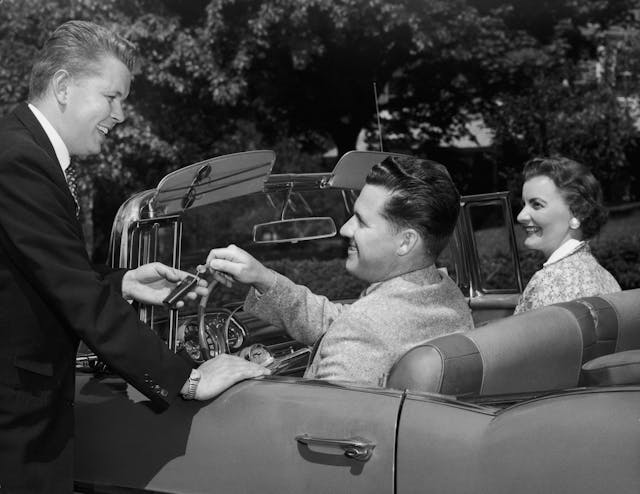
At the time, Chevrolet had a staggering 7500 stores across the country. (Today there aren’t even 3000.)
“Outside the Chevrolet agencies, hundreds of machines spewed forth varicolored bubbles by day,” read a contemporary account of the weeks leading up to the launch. “By night huge spotlights swiveled their beams across the sky. Dealers hung up miles of flags, banners, and placards, hired clowns and calliopes, rented dinner jackets for their salesmen, splashed teaser ads through the press.”
The advance promotional bill for this car reportedly cost $3,500,000—nearly $40 million in 2022 dollars. Chevrolet reportedly gave away 2,131,000 balloons and 1,016,920 bottles of Prince Matchabelli perfume, plus hundreds of thousands of pencils, yardsticks, potholders, key cases, and beanies, all in service of alerting the car-buying public that this new vehicle had arrived.
It was reported that 20 million people entered Chevrolet’s 7500 stores over a matter of weeks in 1954. That’s twelve percent of the country’s entire population. The attention appeared to work. In 1955, between the 150, 210, and Bel Air trims, Chevrolet sold 1.8 million models, a staggering 64 percent increase in sales from that year of pent-up demand in 1949.
The 1955 car was an unqualified success not only on the sales floor but on the track. Compact and lightweight, with a base horsepower rating of 162 hp, or 180 hp with the dual exhaust and four-barrel carb, the small-block V-8 was a smash hit among racers. It would slowly begin to amass more and more victories over the next three years.
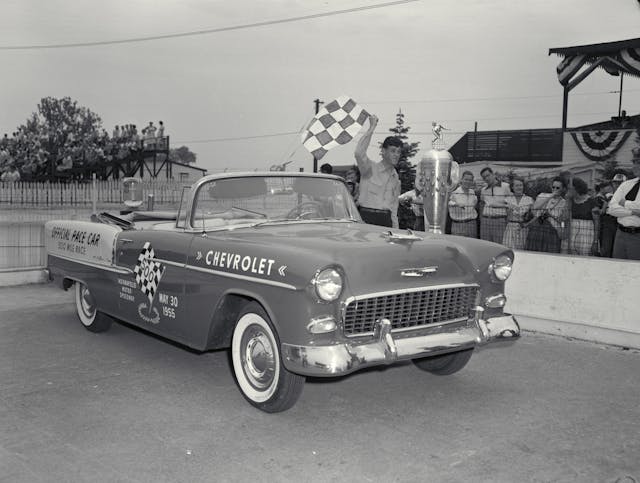
It’s interesting to examine the 1955 season. Fonty Flock piloted a ’55 Chevrolet to victory at Columbia Speedway in March that year, but the next win wouldn’t come until Herb Thomas crossed the line in Darlington in September.
Contrast those two wins with what occurred in 1957: Chevrolet dominated 21 races that year, only bested by Ford, who had 28. The only other competitive cars that year came from Oldsmobile (four wins) and Pontiac (two). Out of 53 races that year, Buck Baker won ten and Jack Smith won four in Chevrolets. If you’re looking for the genesis of the “Ford versus Chevy” rivalry, here it is, on the NASCAR circuit in 1957.
All of this taken in total—the outstanding design, the flexing of engineering muscle, the racing victories, the million bottles of Prince Matchabelli—combined to make the 1955 to 1957 Chevrolet Bel Air a bona fide icon within the three years it was available.
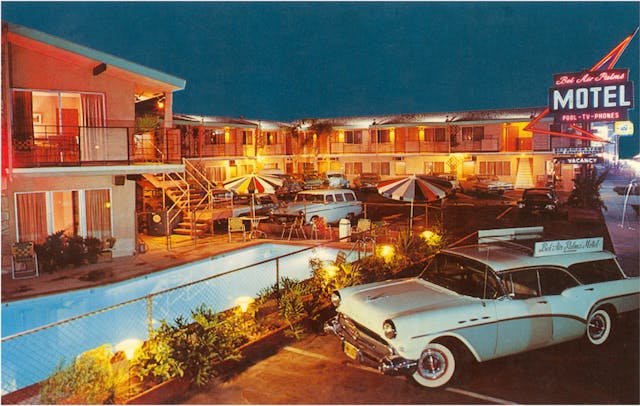
They were an indelible part of American culture from the get-go. In 1962, a trilby-wearing James Bond takes out his captor in a 1957 Bel Air convertible in Dr. No. In 1971, Monte Hellman’s film Two Lane Blacktop used a pair of ’55s, and two years later in 1973 when the same cars wound up in American Graffiti. Those cars were just 18 years old at the time, which is kind of like learning the Beatles went from the Star Club to complete dissolution in just eight years.
These cars are still—and always will be—the epitome of the classic American car.
Charting the changes
The changes year-to year are easy to track, since we’re only talking about three years of production. However, the year-to-year changes are voluminous, even if you leave out the tweaks to trim and appearance.
“They’re all one-year-only cars,” says Matt Powell, shop manager at MetalWorks in Eugene, Oregon. The shop specializes in the restoration and restomodification of 1955 through 1957 Chevrolets and has a long list of clients that have either brought cars back to original appearance or gone the hot-rod route.
1955
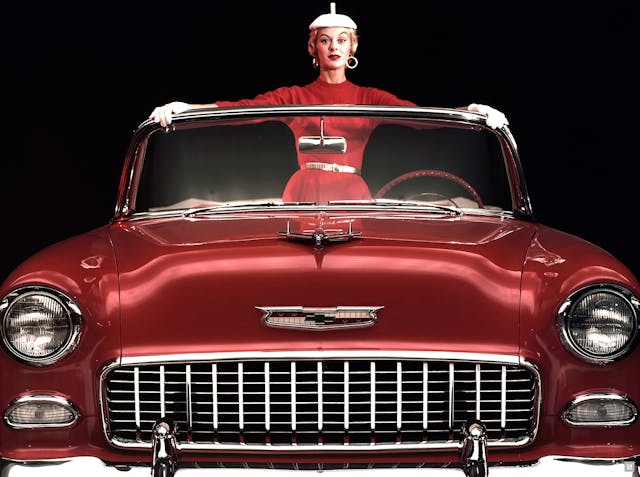
The Hot One, as the Bel Air would be marketed, had all the features of the two lower trims (150 and 210) but had a massive list of additional, standard equipment. All Bel Air variants came with carpet, chrome headliner bands, chrome fender spears, stainless-steel window moldings, full wheel covers, and that distinctive, Ferrari-inspired egg-crate grille. Models late in the year wore a gold Bel Air script.
The top-shelf Bel Air was available in two-door Sedan, four-door Sedan, two-door Nomad wagon, or two-door Sport Coupe (pronounced “coo-pay” in Chevrolet’s 1955 Motorama film):
The Bel Air Nomad was interesting in its significant differences from the other cars. It only shared front fender and door trim with the rest of the Bel Air family. For 1955 only, it had fully radiused rear wheel openings, versus the skirted fenders of the rest of the cars. The Bel Air Nomad shared its frameless door glass with the two-door coupe and four-door hardtop.
Engines included the 123-hp, 216-cubic-inch inline-six; the 136-hp, 235-cubic-inch Blue Flame inline-six; and the 265-cubic-inch small-block V-8. While Chevrolet did offer a V-8 in its D-series in 1917, this was really the first Chevrolet V-8 produced in significant numbers. The engine was a modern design with overhead valves, a high compression ratio, and a short stroke. The base V-8 had a two-barrel carb and a single exhaust, but the Power Pack option provided a four-barrel and dual exhaust for 180 hp. A Super Power Pack offered later in 1955 dialed up the compression even higher, yielding another 15 hp.
The 1955 Chevrolet Bel Air was packed with innovation, from swing-type pedals that eliminated holes in the floor and offered more space for feet to the new “Sweep Sight” windshield that not only looked good but provided a wide view of the road ahead. Additional high-tech features included tubeless tires, “extra large” brakes, and a Hotchkiss driveshaft in place of the old torque tube from the previous generation of Chevrolet cars.
Nearly everything could be ordered with power-assist, from brakes to steering to seats to windows. Bel Airs with V-8s could be equipped with air conditioning, a new option for Chevrolet at the time. These configurations also got a heavy-duty alternator and could be ordered with either transmission.
The transmission offerings at the time were a three-speed manual at the base level and a two-speed Powerglide as an option.
1956
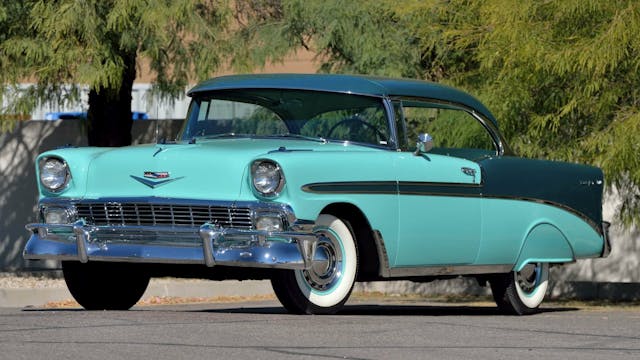
Out of the three years of production, the 1956 is something of an outlier. The 1955 is recognized for its relative cleanliness and that Maranello-inspired grille, while the 1957 is outlandishly bedecked in every chrome accessory imaginable. The 1956 sits somewhere in the middle, but its extensive improvements go well beyond aesthetics.
Design-wise, the car wore a wider grille opening, turn signals moved up to the grille, and fatter chrome spears on the flanks. Taillights had a more jet-exhaust appearance, and the left-side fuel filler/taillight dropped down, rather than swinging to the left as before.

The Bel Air Nomad wore the same fascia updates as the rest of the cars and received standard two-tone paint. The one-year-only, radiused rear-wheel openings were eliminated, in favor of the same style used on the sedans and coupes.
The Bel Air trim level extended to seven body styles in 1956, with the new four-door hardtop Sport Sedan, four-door Bel Air Beauville station wagon, and the two-door Convertible. New equipment for 1956 included a lot of safety technology, such as optional seat belts, shoulder harnesses, and dash pads.
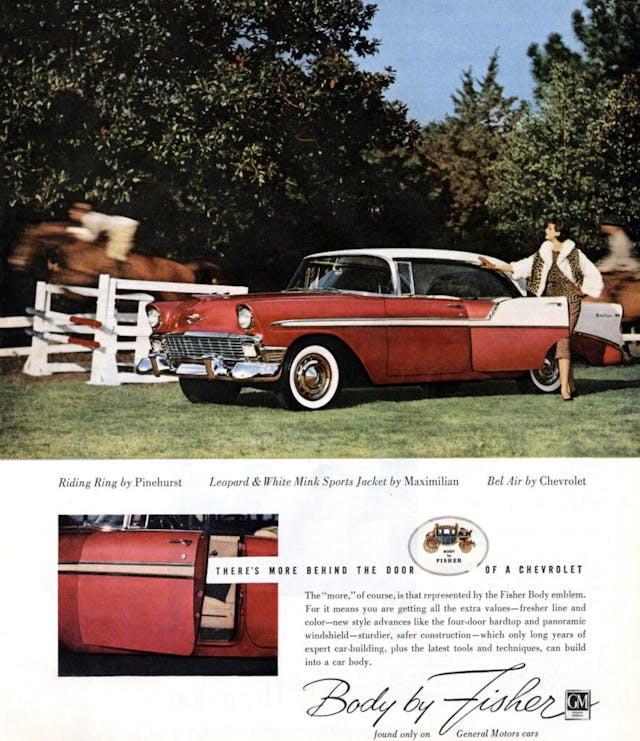
Engines were revised to eliminate the base six-cylinder. Instead, the range started with the Blue Flame 140, which superseded the two sixes offered in 1955 with 8:1 compression and a high-lift cam.
The next step up the ladder was the Turbo-Fire V-8, which for 1956 received significant changes. Regardless of horsepower ratings, the V-8 received hydraulic lifters, which were only available on cars equipped with the Powerglide automatic in 1955. A full-flow oil filter in its own housing was mounted under the engine to the left of the oil pan. The filter was a factory option, replacing the dealer-optional oil filter that stood on top of the engine block.
The base V-8 with a manual transmission was unchanged, but when a buyer purchased the Powerglide automatic, the V-8 had a higher-lift camshaft, which raised engine output to 170 hp. The Power Pack came with a four-barrel carb and dual exhaust, along with 9.25:1 compression. The Bel Air wagons got the Power Pack as standard equipment, including the dual exhaust that wasn’t available in 1955 thanks to the shape of the fuel tank. The engine also got a heat riser on the intake to prevent icing.
Spring rates were reduced for all Bel Air models with the exception of the convertible and the wagons, due to their increased weight. Caster angle increased by one degree, and the tie-rod ends were raised a bit to accommodate the change. Rear spring hangers were widened by an inch in order to fit thicker rubber bushings, and the nine-passenger wagon got a six-leaf spring pack.
Even the wiring harness got an update. In place of one continuous web, the main harness terminated at a plug in the firewall, where an extension harness plugged in to power the lights, horns, and voltage regulator. Self-canceling turn signals were standard across the board in 1956.
1957
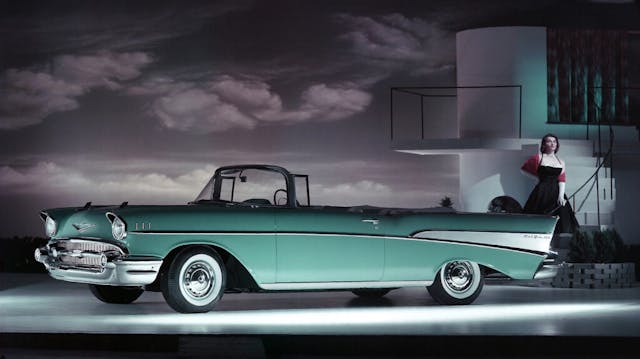
“Exciting new looks,” “zippy new power,” “luxurious new interiors,” and a “revolutionary new Turboglide” automatic transmission were all called out on the opening spread of the brochure in 1957. Gold anodized trim is the first thing that jumps off the sheetmetal as a differentiator between 1957 and the other two years, along with full-disc wheel covers and a “rakish sweep of chrome.” In the four-door Sedan, the car boasted 75 square inches more glass area than the previous years did.
Up front, the grille changed for a third time, into a combination grille/bumper highlighted by its “note of massiveness and width.” The grille bar terminated in parking lights. The fenders were redesigned to push the headlamps further out, and the hood has twin wind splits for the first time, in place of the original hood bird. At the rear, the tail lamps transformed into the classic, chrome-surrounded, fin-with-afterburner design.
The fuel-filler door remained in the fin, but, for the third consecutive year, sported a changed design—this time, to incorporate the vertical chrome alone the fin.

Inside, the ’57 Bel Air models featured new contemporary styling with redesigned “slenderly crafted seats” upholstered in Jacquard-loomed cloth and vinyl. The seat tracks were redesigned to yield a greater range of motion and front seat headroom. The ’57 Bel Air also had larger door armrests than the prior year.
Mechanically, the Blue Flame six was still the base engine, and the optional 265-cubic-inch V-8 still provided 165 hp. Sporty drivers stepped up to the new 283-cubic-inch motor, which was available in four different levels of performance: The two barrel–equipped 283 delivered 185 hp. The Super Turbo Fire had a four-barrel and dual exhaust, with a bump to 9.5:1 compression for 220 hp. The “Corvette” V-8 was rated at 245 hp, and a competition version of the engine went up to 270 hp with a bespoke camshaft and a high-speed valvetrain.
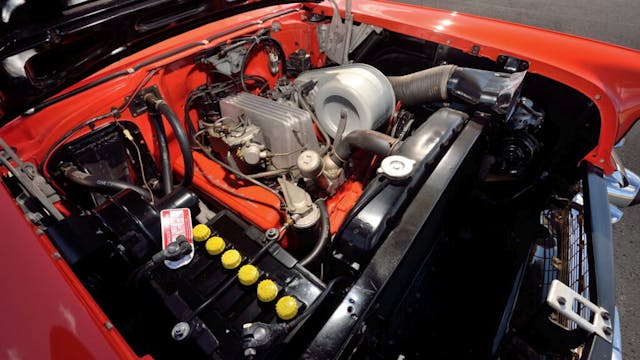
Aside from the availability of the new Turboglide transmission, the biggest news for 1957 was the Rochester Ramjet mechanical fuel injection system. That system was originally intended to completely replace the four-barrel carburetors, according to the info in the engineering booklet supplied to Chevrolet dealers. It raised horsepower on the Corvette V-8 to 283, which fit neatly into Chevrolet’s “one horsepower per cubic inch” marketing plan.
According to a contemporary story in Popular Mechanics, 34.4 percent of 1957 Chevrolet owners wanted fuel injection. But the reality told another story. The primary beef with the early system on the ’57 was that the cold-start fuel enrichment was either on or off; since it did not gradually step down, it produced running issues when the engine was cold. Vacuum-operated crank signal valves often failed, causing rich running conditions that led a lot of fuel-injection systems to be abandoned in favor of a traditional four-barrel carburetor.
Who to know before inspection
If you’re bound to purchase a 1955 to 1957 Bel Air, there are nearly limitless resources at your disposal. Tri-Five Chevys has a forum with over 3450 members active in the restoration and use of these cars. The American Tri-Five Association is a more traditional club that offers a number of benefits including a color print magazine, discounts to club-sponsored shows and parts suppliers, and free shipping on items from some vendors. Depending on where you live, there’s a community of like-minded enthusiasts in your area, either as a chapter of one of these organizations or an independent club.
VIN decoding is relatively simple because these Chevy’s VINs are short. On the unfortunate side, the codes don’t tell you much about the car other than trim level and body style, production year, and build location. You can find a version of the VIN decoder at the San Jose Classic Chevys website or at parts supplier Classic Industries.

We asked Matt Powell at MetalWorks regarding which specific years, body styles and options are most desirable. He says that this decision largely swings on what you’re looking for out of the car.
Most of his customers at this point are looking for cars to modify, swapping the body onto a more modern chassis and driveline. In that case he’s clear in his advice: “We’ll have $60,000 to $70,000 in paint and bodywork alone,” he says. “Find a car that you like the appearance of and use that as a starting point.”
If you’re looking to restore one of these cars, Powell’s advice is to find one that’s as untouched as possible, so that you know what you’re getting into before you even start. The earliest of these cars are now 65 years old, so finding one with original paint and interior is tough; but you don’t want a car with layers of paint hiding lousy bodywork.
Factory build, or “Regular Order Passenger,” sheets are much less common to find in 1955 to 1957 cars, having been lost to time or never stuck under a seat in the first place. When they are found, they’re an invaluable resource for finding out what options were on the car, and they’re much simpler to read than some of the later order sheets.

Cowl tags are important for learning paint and trim information. Classic Industries provides a Trim Tag Decoder at its website. Major options like air conditioning, power windows, and seats will appear here, but minor options won’t.
At the moment, the GM Heritage Center’s Historical Information Packets that were available free of charge seem to be gone from the internet. Our sources at GM tell us that this is a temporary situation, so check back with the site frequently to learn more. These packets provide a wealth of information, including original brochures, technical specifications, order guides, and more. This resource was up and running for years up until about a month before this writing, and the information within hasn’t been made available again.
Before you buy
These cars are as susceptible to rust as any mid-century vehicle. All of the usual cautions apply: Look for rust in the frame, body mounts, door bottoms, fender bottoms, rocker panels, and both passenger-side and trunk floors. The good news is that just about everything for these cars, from trim pieces to entire body shells, is available on the aftermarket.
Matt Powell gives a few words of caution: “Nomads and [9-passenger Beauville] wagons are hard to come by, and some of the individual parts for those cars are expensive.” He points out that the paint divider on the wagon can be $900 per pair, and are only available from recyclers. “You can buy those for $50 to $80 a set for most of the other bodystyles,” he says.
Exterior trim, when it’s present, can be overtightened and misapplied, leaving the trim dented and distorted. The trim can be restored, but it can be a labor sinkhole.

Mechanically, these cars are pretty straightforward with a few exceptions. The early cars, or those without an oil filter at all, can be the subject of multiple engine rebuilds. Larger pistons will be usually be marked on the top, visible with a borescope that will at least tell you where you’re starting.
Loads of these cars have been updated with Rochester fuel injection, even ones didn’t have it from the factory. Conversely, loads of these cars have had their Rochester systems removed and left on the scrap-metal pile circa 1958. Anything that provides information as to whether or not the car should’ve had fuel injection is key in assessing the car’s value.
As far as which car to buy? Matt Powell says that it’s all up to the buyer’s interest, but that the two-door Sedan offers great curb appeal with fewer issues than the two-door Sport Coupe. “The window flippers on the Coupe are often a problem,” he says, “and the body on the coupe tends to sag more than the Sedan would.”
What to pay
“The range of values of these cars is huge depending on engine and body style, but on the whole their values have been incredibly steady relative to the rest of the market,” says Andrew Newton, senior auction editor at Hagerty.
“Many 1950s American cars have been flat or gone down, but Tri-Five Chevys, being as recognizable as they are, have at least kept their value in the broad sense, but have dropped approximately 4.5 percent over the last five years at the median, condition #2 [Excellent] level.”
It’s also hard to put a value on a “Bel Air,” since there were so many body-style variations after the first year. Naturally, Sport Coupes and Convertibles are going to sell for significantly more money than a four-door Sedan. In the same condition, a two-door Nomad is going to sell for orders of magnitude more than the 9-passenger Beauville.

Record auction prices for a modified 1955 Bel Air Convertible hit $363,000 at the 2019 Barrett-Jackson Scottsdale auction. An unmodified, restored 1957 Bel Air Convertible sold for $198,000 at the same auction a year later.
Of all of the cars Hagerty insures, the 1955 to 1957 Chevrolet Bel Air is the sixth most popular. Quoted values for these cars have increased 17 percent over the last three years, according to the Hagerty valuation team. As you’d expect, the typical owner skews toward the older end of the range but not as dramatically as they would for other American cars from the 1950s.
Gen-X surprisingly quotes 29 percent of Bel Airs, though they make up 32 percent of the overall collector car market. Millennials, who make up 21 percent, drop right off to 13 percent of quotes. Gen Z barely owns these cars, representing just 1 percent of the quotes in Hagerty’s database, despite comprising 7 percent of the overall market.
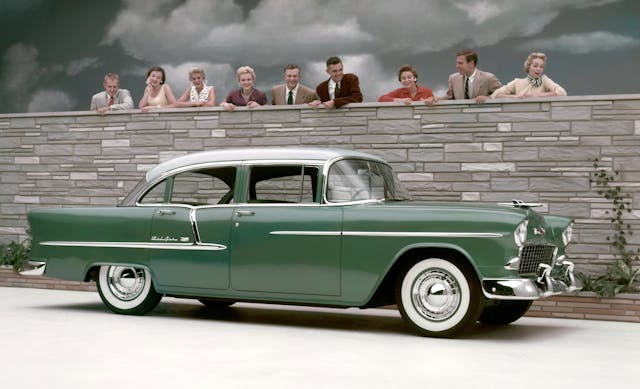
As you’d expect, Boomers are the core audience, quoting 47 percent of all ’55 to ’57 Bel Airs in Hagerty’s database, while making up nearly the same percentage of the market (32) as Gen-X. Pre-boomers quote 10 percent of these cars, while owning just a five percent share of the market as a whole.
In general, all of the typical information holds true for these cars: Buy the best one you can afford, and let the previous owner take the hit for restoration cost, provided you can have the car looked over by a qualified professional.
Check out the Hagerty Media homepage so you don’t miss a single story, or better yet, bookmark it.
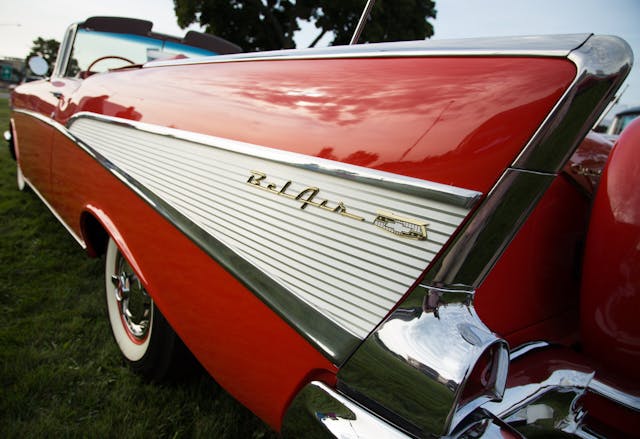
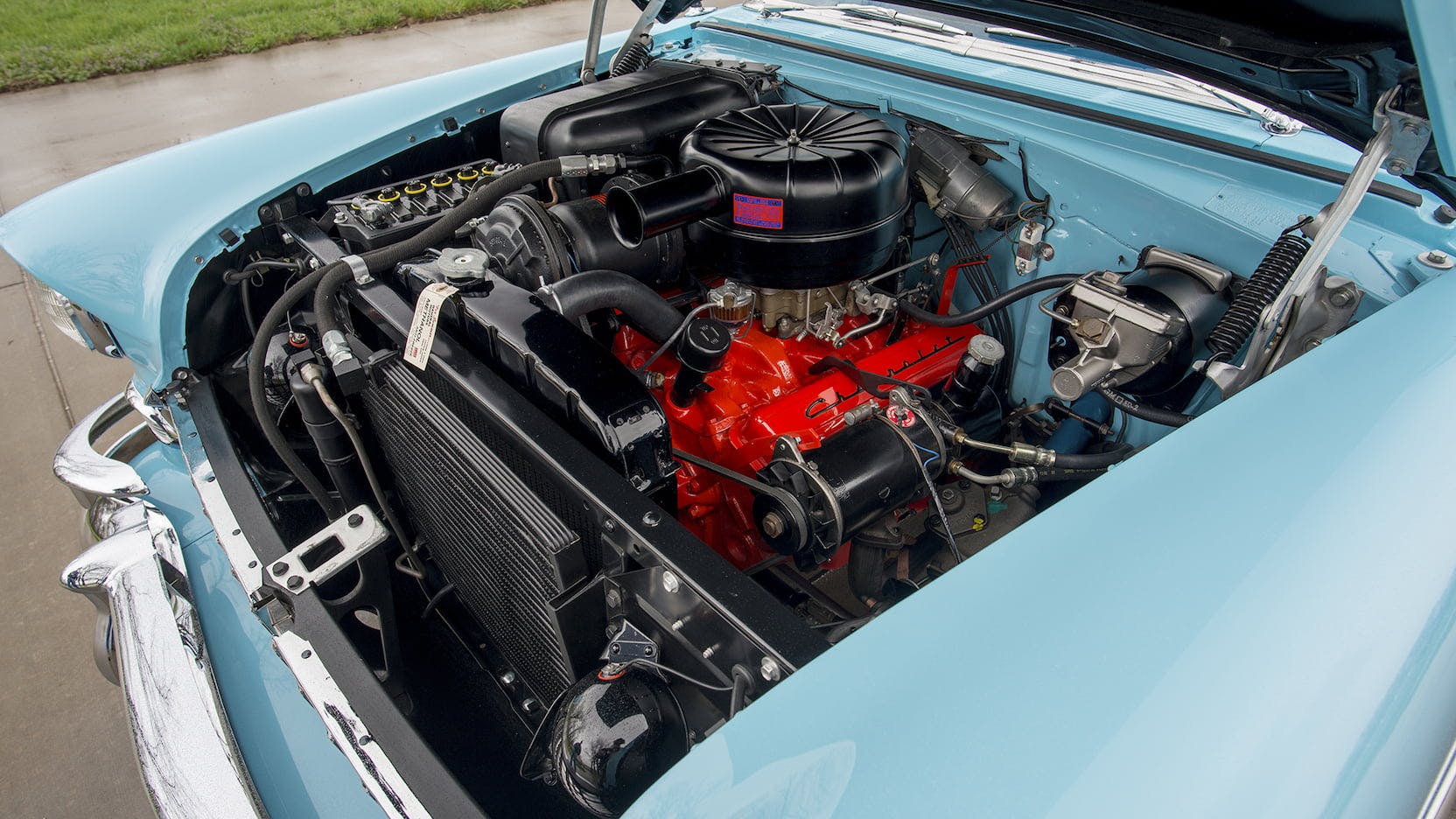
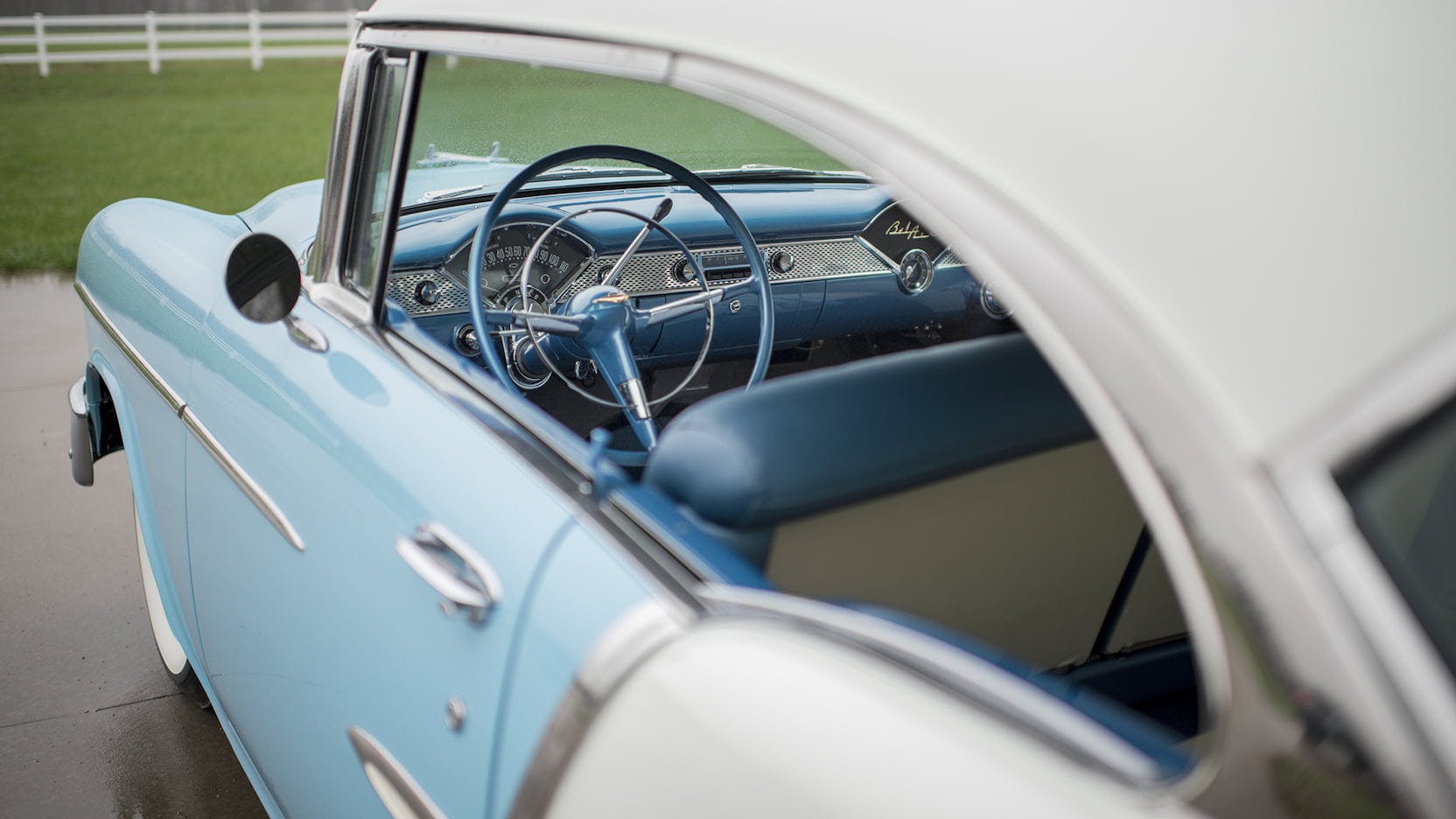

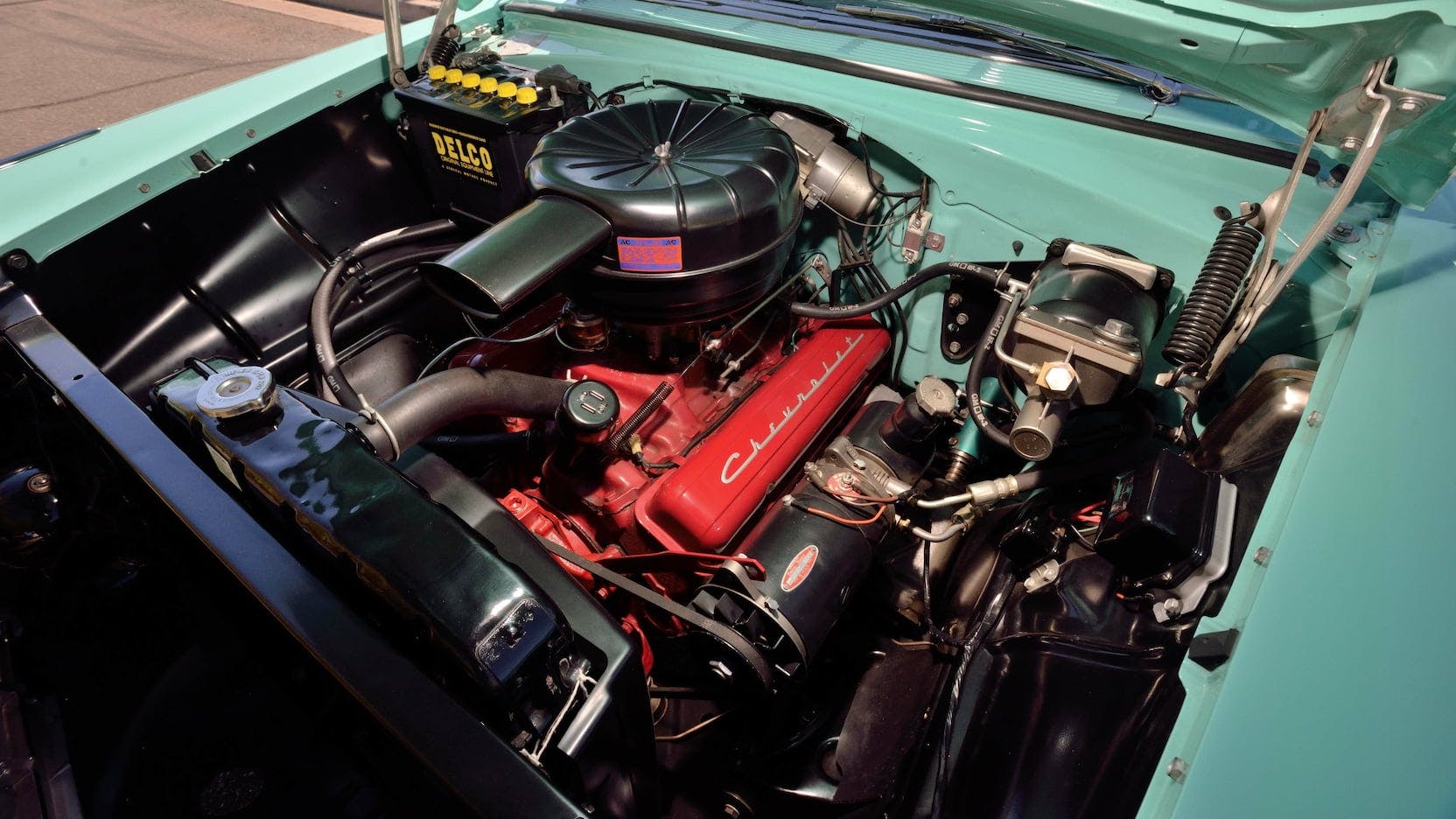
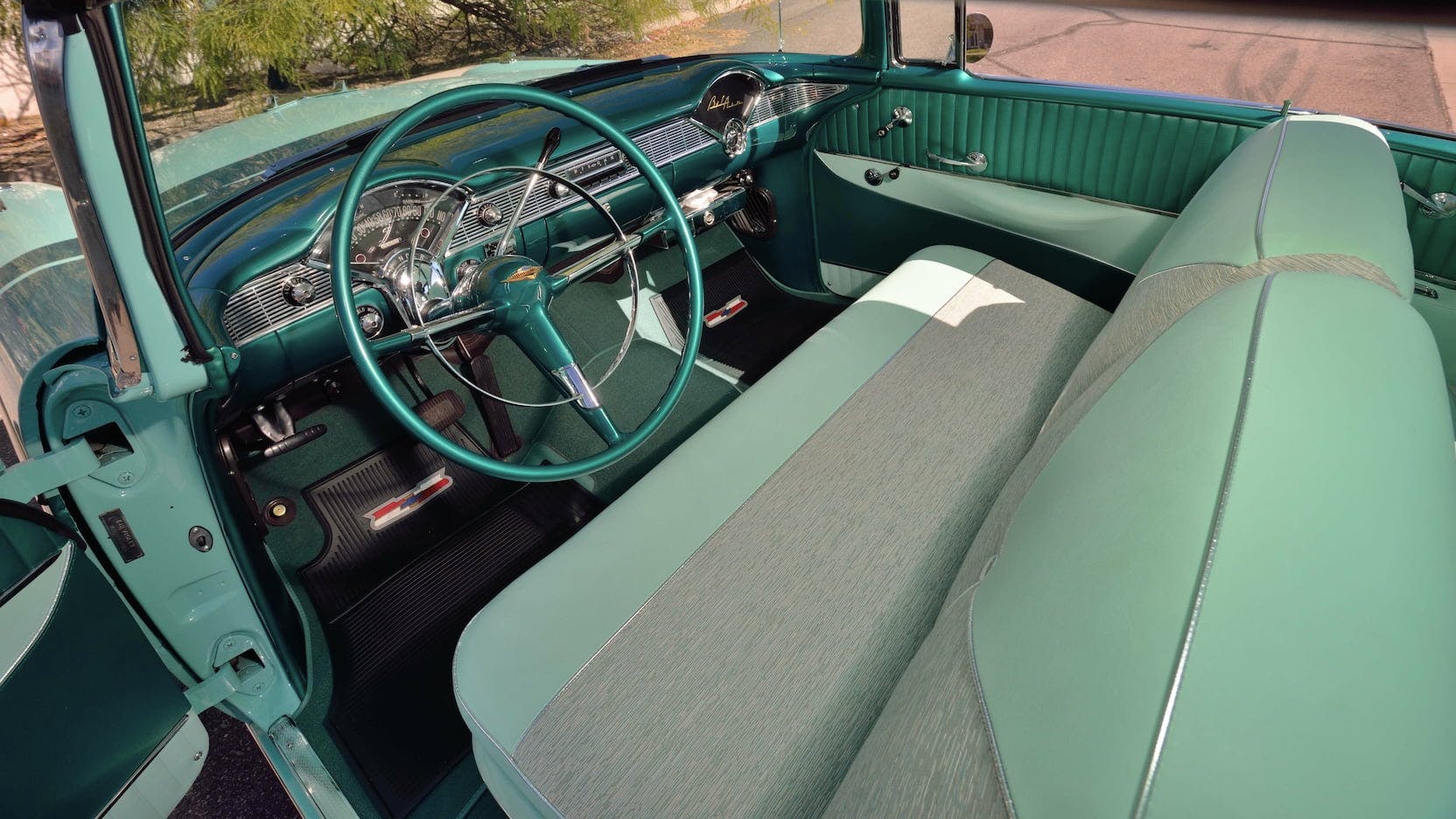
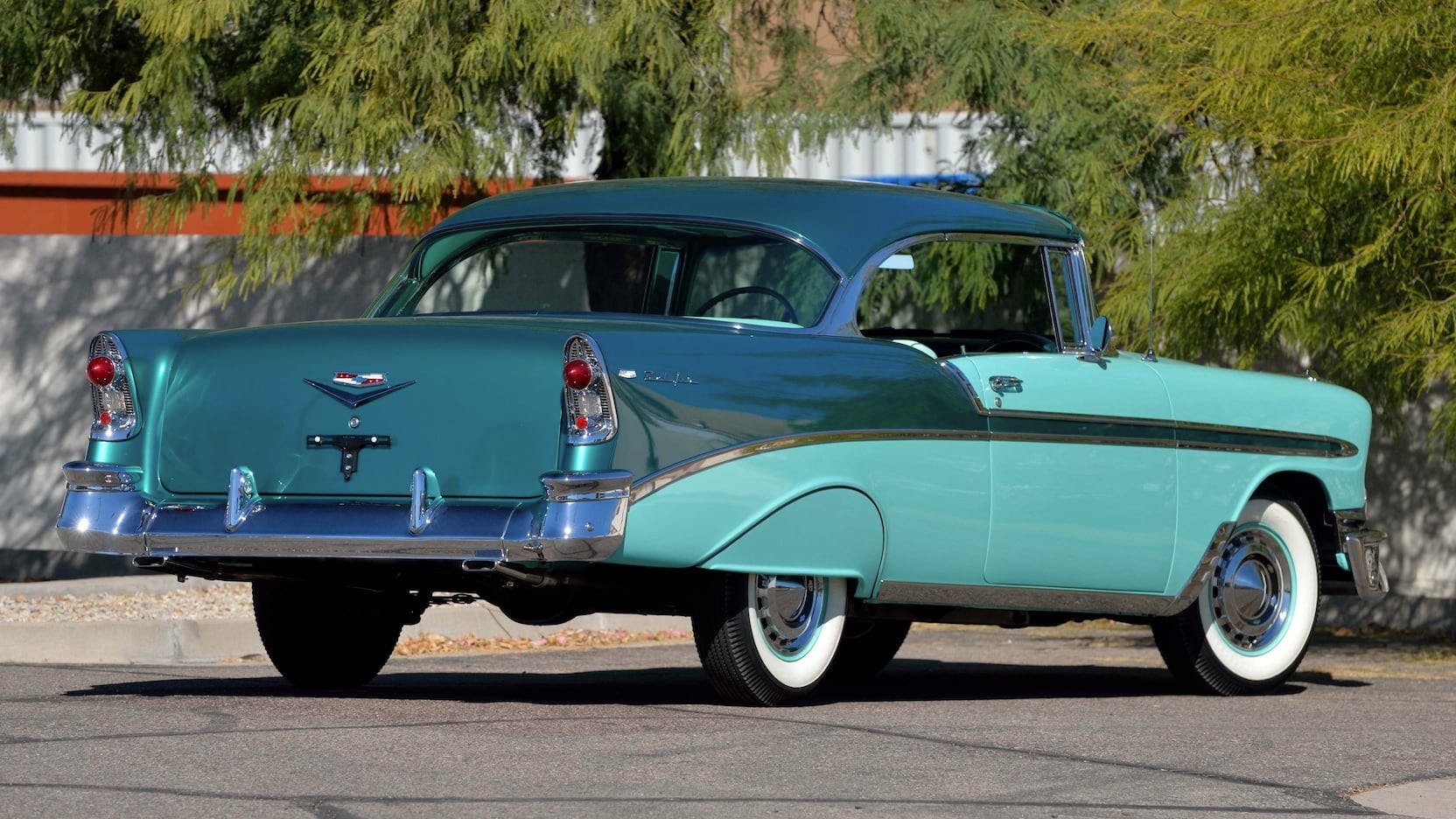


In a previous article about tri-five Chevys, a commenter wrote:
“What is Ironic is the impact of the Tri Fives was not really felt till after they left production. Keep in mind the 57 Ford out sold the 55 Chevy. The 58 most snubbed…Too much history in hindsight is not always as it really was. The Tri Five cars were not legends till later and it was the hot rod community and racing that really crowned the car as a legend.”
I would argue that most of the statistics in THIS article counter that statement. The reference to “The 58 most snubbed” has absolutely no relevance to discussion of tri-fives, as it is clearly not one of them. Regardless of what kind of sales year Ford had in ’57 compared to ’55 Chevys (oranges and kumquats?), it’s clear that the tri-five Chevrolets had an immediate impact on the culture and excited a LOT of car-buyers. Not sure if the other commenter was around (or old enough) to remember what happened in 1955, but I certainly was around. And I clearly remember my father coming home with a brand new 1955 Chevy in the fall of 1954. He brought me a balloon!
It’s true that the tri-fives have outpaced nearly all other “generations” of almost any automaker in gaining and maintaining the American imagination. But I think that it’s abundantly clear that they started trat trend in 1955, and not “after they left production” or after they were hot-rodded or won a few races.
You mean on a basically duplicate article. Far too many of these. I get the feel I have read this article before about 25% of the time because I have on a previous day.
I Have Had A 57 And A 55(The 55 Is Off-Frame Restoration. Complete 2020
I have a 57 4 door Bell Aire. In fair condition but I always lusted after a convertible. Be satisfied tom
I’ve written before about one of the biggest “fumbles” I ever made in my life, but the mention of “lust for a ’57 convertible” brings it back to mind here. I once (late ’60s, I think) bought a ’57 convertible from (and I swear this is true) a little old lady whose husband had passed. They had driven it on Sunday drives, and it was showroom stock. Two-tone with white interior, dual antennas, fender skirts, wide whitewalls, PowerGlide, and a continental kit. She asked $250.
I was a hot rodder, and when I showed up the next Friday night at the car-guys’ hangout, I was nearly laughed off the lot for my “Little Old Ladie’s Car”. I determined to rod the car as soon as I could, but in driving through a subdivision, I saw a ’56 Bel Air hardtop with a 4 Sale sign. It was jacked up, had wide TigerPaws on reversed chrome rims, a 4-speed and an 8-track. The guy wanted $400, but I was short on cash.
I drove back to the lady’s house and pled my case – she returned my $250 and blessed me!
So, in the big scheme of things, I may have ruined the car by rodding it and not even saving the OEM parts – don’t know. But if I had, by some twist of fate, kept the car and could restore all the original parts, I think my retirement account would have looked much better when I got to that age!
Oh well, I hope whoever bought the car after I turned it back was smarter than me, and they are sitting on a beach in Fiji or something, toasting that $250 investment they made back in the ’60s!
Why is it whenever I hear someone talking tri-5 it’s always about Chevys? I own a mostly OEM (all original trim, paint scheme) Ford Ranchero which came out 2yrs ahead of the El Camino and yet, when people see it they ask “issat an El Camino?” When I had it shipped from Cali to Tennessee the driver told me every time he stopped for fuel and other essentials he’d come out to crowd standing around his rig appreciating the Ranchero, some asking and others demanding the same as above (Elco). Tri-5 Fords are just as beautiful and you’ll never see an OEM Ranchero (or rarely). I’ve owned my Ranchero since 1973 and it’s been a little upgraded with the torque building 312, a power glide transmission (with a 3grand stall speed), Holley 4barrel and a limited slip dif. All from ‘57’s. I upgraded it with my dad in 1974. But ya just never hear people gush over the trend setting tri-5 Fords (except DUB6- thank you!). I’ve seen fully restored Skyliners and such, but they were bought restored. Yeah, mine has some dings and chips but I can tell you where every one of them came from. In closing, it’d be nice to see some recognition for tri-5 Fords. They’re just as beautiful as the Chevy. If you need some help with your tri-5 Ford hit me up. I can answer a lot of questions about them. Thanks for reading.
God bless America!
HOO-RAH!
What you’re seeing in your comment is the tail end of just how overwhelming GM was back in the 1950’s and 1960’s. My father was the Chevrolet dealer in Johnstown, PA back in those days, and, as we moved into the early and mid 1960’s the big discussion around the Paczolt dinner table was the possibility of the Federal Government breaking General Motors up into two companies (bets at home were Chevrolet-Cadillac and Pontiac-Oldsmobile-GMC-Buick) because at the time General Motors was such a juggernaut that it was felt that no other automobile company could successfully compete against them. I believe at their height they were selling 52% of all the cars in North America?
In the 1950’s Ford was desperately trying to hang on, and not doing all that well in their efforts (Mercury-Edsel-Lincoln, anyone?). They’d only take back the #2 spot in the Big Three in the late Forties due more to Chrysler’s missteps than their own good moves. And the market realities of the Fifties still hangs on today in the cars we fondly remember
Thoughts from a person who’s father was a Chevrolet dealer back when these cars were new (and despite my having been a child at the time, my memory is rather vivid):
The single biggest reason these cars became so popular, both when new, and especially long after the Fifties were a memory, was the quality of their build. To this day, these cars have a reputation as being the best cars the Chevrolet Motor Division ever built, and we’re not just talking hot rodding and performance. The 55-57 cars were as close as you got to absolute quality back in those days, and especially had a reputation for being better built than anything Ford was putting out at the time. Plymouth still had a good construction reputation (to be trashed with the 57’s) but was dragging itself back from a six year nadir of styling and image.
This quality reputation was reinforced by the resale value of the the cars. Check back on used car ads from the late Fifties, where you’ll see that a Chevrolet is selling 10-15% higher than a Ford or Plymouth. I can remember well as a child that Chevys were definitely more desirable used than Fords.
Yes, the ’57 Ford outsold the ’57 Chevy. Three years later that Ford was rusting out around the headlight nacelles while the Chevy was still holding together just fine. The less said about ’57 Plymouths, the better. How many ’57 Ford’s and Plymouths do you see surviving now? Yep, rust.
Chevrolet was unfortunately tied to the tail end of Harley Earl’s career, and it’s painfully obvious that the ’57 was a quick job so the design department could put major effort into the ’58’s. (Incidentally, all my life, while I’ve loved the ’55 and ’56’s, I cannot understand the love for the ’57’s and consider it the most overrated collector car out there. Given a choice, I’ll take a ’58 over a ’57 any day, and still fondly remember dad’s silver blue Impala hardtop. I have no memory whatsoever of what he drove in ’57.)
Also, going slightly off-topic: While Ford squeaked out a slight sales win in ’57, Chevrolet absolutely crushed them the following year. Look at the two cars, and it’s painfully obvious why.
Getting back to the usually overrated performance (which wasn’t THAT critical, at least not to a four door sedan family man buyers, of whom were the majority). The Ford Y-block was not Ford’s finest moment when it came to engines. It put out reasonable horsepower, but was definitely running third in the Big 3 V-8 race, being overly heavy and not all that terrific to hop up. Meanwhile, the small block Chevy was the start of a legend.
Yeah, there’s a reason Tri-Fives are so popular. Start with survivability, add in the drivetrain, and go from there.
Just a heads up, but the dominant TriFive forum is TriFive.com, over 54,000 members.
Find anything you could ever need to keep your Tri Five on the road at:
Facebook.com/groups/trifiveswapmeet
52,000 members buying & selling.
The article states that the 55 Bel Air with air conditioning had a heavy duty alternator. My 58 Impala had a generator and my 63 Corvette has an alternator. Not sure when the change was but I think 55s all had generators.
No really a 50s lover but I don’t understand why the 58 impala seems to be totally ignored when talking about the golden era of 50s cars. If I was going to buy an Oder vehicle from that era it would be the 58. Just my opinion.
the 58 is a beauty but the style was changed and design for 59 like the 60 ford falcon one off
A 56 Belair rextorted and ready to racehttps://m.facebook.com/photos/viewer/?photoset_token=pcb.10160867935608373&photo=10160867935113373&profileid=635143372&eav=AfbYMLly61dzG-ZyVNmRWtLR5kkJiaVIsWpSQpULMJm5RFTC_Mi1_wFtWgKvF1t-wZg&paipv=0&source=49&refid=17&_ft_=encrypted_tracking_data.0AY_lhXhT14xYqRq9M6F4eS_H3BFrGv5gMkGZribgMfrX0bT796VFFgBjfB3xJ2S44VMp2RiFv_lYJZOSHXtPo0Cn_dVxbUV1nCbgbZLVwKRyr9P-kh11eNCDzjlGxwf2bydWrexL76EwAues4DJgwYiRVcO4efICjZfN6I9OnydSqsSenIG_MRdu3ewgpaD0ROHb5JVTQhI0kFpYTDnyuny05uZv3PAVDqq2ncCuZ15xEfo6s231fyfK0TXzEygKibEOItoqvzReOWX46kcg9ulc2Y9OZAfW0SiP4hBQ6yc0l6sX0y5mO7ZWKxVJSf2ZU7BalRS9HKXhwKdsZqRaoItxw-gQdTlOp1Q-0HpovZraQfm0sCsNfgutjhZowt-lh0OFoRk2iei7bofuF9qqdJ2zvmQVr_rdoHKD3fzVS6jRe9R0Ts5MuFDvSwhxB04GBjO2fhzt393BPqlgx56G5UtONCdSg-OkUNkVAgUdRU906R-N_F9cvewLV4A8-Ve5JG2WxVNDPlAKElAaN9rSUbpPOmw3twUsvW5YyRIFAn_so1CiyxpJ43NTpTHeKxC3vaniHyxnyEdxghUq3-9LfknPdQe9ToT5C0gGbnzAVTTwCgufL-H4Lckaa-oe1KnxwIyazitPSRoctSfjNDsDO2BzhzlHrhxffDo1U8hDjYeLJbjRw2lWrb46tAh2A_Gg5HM_oDT-pkaxt_wBhH_MzAOfUV4LAxuWaYLq7lnkz9fzOCLOFHwAKN02PV3kydsQpjo2LD_1-fpwzqBqAVu9rolPHeitYixbi7SYC7cbrsDyeCogC6AblSzTluUGNcvHiJxwr_RndIBJ6xtj3MfWyk0_4Rq6R8kIng&__tn__=EH-R
Hagerty insures both of my beautiful 57 chevys.. I have a Bel Air 2 dr. Hit. With a complete frame off restoration, Inca silver the original 283 and 3 on the tree. I also have a 210 2dr. Sedan rust free partly restored yellow with a 350 crate and auto Trans. I love em both and drive them often At 76 yr. old someone else will soon be their ccaretaker………
1956 chevy my favorite but can someone tell what difference is there between 150 model and the 210 model